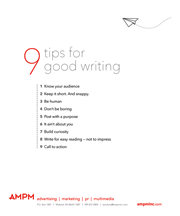
Presentation recap: 9 tips for social media writing
- Friday, 22 January 2016 14:32
- Written by Julie Foster
Last week, Julie Battle and I had the opportunity to present at the Seminars from the Pros event hosted by Social Media Club Great Lakes Bay. What a wonderful opportunity for attendees to learn tried and true tips from local professionals – everything from photography and video to social SEO, Facebook ads and graphic design – in just 90 minutes. While Julie Battle presented her top tips on good writing, I showed examples of how these tips have been used successfully (or not so successfully) in social media. Here are the nine tips:
1. Know your audience.
When your audience is unclear, it makes writing painful because it lacks focus. The tighter the target, the easier it is to create and sustain awareness and appeal. As you research your primary audience, you should be able to identify their age, gender, geographic location and socioeconomic status.
2. Keep it short. And snappy.
While you always want to be grammatically correct, it’s okay to use short, punchy statements. Also:
- Aim for simplicity.
- Remove a word here and there.
- Take off the “ing.” Instead of “we’ll be working hard to earn your business” try “we work hard to earn your business.”
- Use subheads or bullet points.
If you try to emphasize everything, you emphasize nothing.
3. Be human.
Take the wall down and speak directly to your reader by writing like you speak. Make your language less technical and more practical. Be helpful by taking large amounts of information and drilling them down into bite-sized chunks.
4. Don’t be boring.
The most valuable content on social media is content that gets the most engagement. Is it interesting enough that users might pass it on and post it? Does it add value? Is it positive or helpful? Try to write about something new as it relates to your business – put a new spin on it.
5. Post with a purpose.
Have a purpose beyond pushing your brand so you’re not posting blindly. Make sure your writing is relevant to your website, your business and your users. Focus on needs and wants, not so much what you want them to do. Know your goal or purpose – but take them there via what they want.
6. It ain’t about you.
Does anyone care about it besides you? Make the writing and message relevant to your audience. Use storytelling. People always say tug at the heartstrings. Instead, give them a dart to the heart.
7. Build curiosity.
Make the reader want more. It’s a relationship that you’re trying to build – two-way communication. Get them talking to you. Give them a reason to tune in for more information and invite their input. And when they provide it, be sure to answer!
8. Write for easy reading, not to impress.
This goes along with short and snappy. Too many times we speak in our own language by using acronyms that only our business understands. Pretend you are talking to a neighbor or relative. You can impress by providing advice or posting articles of value – but not with words the reader has to look up.
Remember, most people don’t read social media copy – they skim it. Make sure your key points come through easily.
9. Call to action.
Want your social media audience to take action? Don’t leave it to chance. Don’t be shy in telling your audience exactly what you want them to do. Whatever the call to action, you need to write it in a way that they can’t help but take the step you want them to. The call to action may be used to spark a thought, cause them to think and then eventually to act.
 During our presentation we included examples of these tips by using real-life examples from different brands. For the sake of length we did not include examples in our re-cap. But we’d be happy to share these examples if you’d like to see them – send me an email at This email address is being protected from spambots. You need JavaScript enabled to view it. And in keeping with Tip 9 – give us a shout or send us a short note – we’d be happy to answer any of your questions regarding “good writing.”
During our presentation we included examples of these tips by using real-life examples from different brands. For the sake of length we did not include examples in our re-cap. But we’d be happy to share these examples if you’d like to see them – send me an email at This email address is being protected from spambots. You need JavaScript enabled to view it. And in keeping with Tip 9 – give us a shout or send us a short note – we’d be happy to answer any of your questions regarding “good writing.”



 Julie Foster
Julie Foster Lindsay Henry
Lindsay Henry Greg Branch
Greg Branch Julie K. Battle
Julie K. Battle